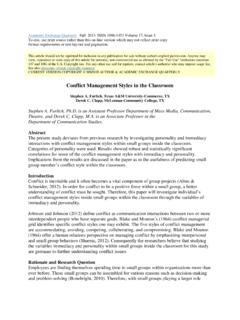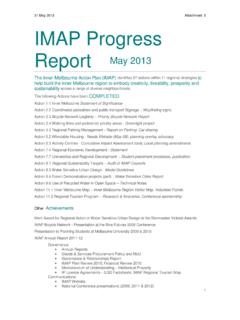Transcription of Social Media & Communication Outcomes in Higher Ed
1 Academic Exchange Quarterly Fall 2013 ISSN 1096-1453 Volume 17, Issue 3. To cite, use print source rather than this on-line version which may not reflect print copy format requirements or text lay-out and pagination. This article should not be reprinted for inclusion in any publication for sale without author's explicit permission. Anyone may view, reproduce or store copy of this article for personal, non-commercial use as allowed by the "Fair Use" limitations (sections 107 and 108) of the Copyright law. For any other use and for reprints, contact article's author(s) who may impose usage See also electronic version copyright clearance CURRENT VERSION COPYRIGHT MMXIII AUTHOR & ACADEMIC EXCHANGE QUARTERLY.
2 Social Media & Communication Outcomes in Higher Ed Shelley D. Lane, University of Texas at Dallas Shelley D. Lane, is the Associate Dean for Undergraduate Education in the School of Arts & Humanities at UT Dallas. Abstract The idea that Millennial Generation students are digital natives and those who teach are digital immigrants has produced urgent calls to incorporate Social Media into Higher education. However, this literature review demonstrates that the digital divide lacks empirical support and that extant research about the influence of Facebook and Twitter on Communication Outcomes often lacks a theoretical base. Nonetheless, faculty should consider integrating Social Media in their courses as early research suggests that Facebook and Twitter can enhance student perceptions of instructor credibility and immediacy.
3 Introduction In Teaching Generation NeXt: A Pedagogy for Today's Learners, Mark Taylor, asserts that: Faculty struggle to effectively teach our traditionally aged students from Generation NeXt. They are different, and different kinds of learners, than anyone Higher education has experienced in the past, and there is ample evidence of a growing divide and mismatch between faculty and students in teaching and learning.. few schools, beyond making online course management systems available, have truly leveraged students'. digital preferences and available online-anytime resources toward learning goals (2010, p. 192). Digital natives or Millenials process information and think differently compared with their parents' generation (Prensky, 2001).
4 The idea of a digital divide caused by digital natives who have different learning styles has produced urgent callas to implement more online courses and to incorporate Social Media use in academia (Helvie-Mason, 2011). Researchers in education and educational technology, scholars in economics and management, university advisors, and student affairs professionals promote the integration of Social Media in university courses and activities to meet the needs of digital natives (Helvie-Mason, 2011; Levine, 2010; Selwyn, 2011;. Tay & Allen, 2011). This literature review seeks to answer the question, Should we integrate Social Media into college and university courses? After a brief description of the Social Media platforms Facebook and Twitter, two Communication -based education Outcomes are explored; student perceptions of instructor credibility and instructor immediacy.
5 The digital divide is analyzed and a synthesis and critique of research concerning instructor credibility and immediacy and their relationship to Facebook and Twitter is presented. Implications for integrating Facebook and Twitter into Higher education courses and suggestions for future research are provided in the conclusion. Characterization and Student Use of Facebook and Twitter Established in 2004, Facebook was originally created for students at Harvard University but expanded to other university audiences and eventually opened to anyone over the age of 13. In June 2013, Facebook revealed that it had over billion monthly active users, and approximately 665 million users are active on the site on a daily basis (Smith, 2013).
6 Facebook is a Social Media platform utilized by people who want to stay in touch with friends and family, and by organizations that want to market and advertise their products, services, and viewpoints (Facebook Fact Sheet, 2012). Users can create a profile and request to friend others who already have profiles to gain access to their status updates. Status updates consist of brief comments that are visible to friends, as are photos and videos posted for sharing. Research illustrates that whether or not Facebook is purposefully integrated into the university classroom, students are using Facebook in university settings to reflect on the university experience;. exchange practical and academic information; display engagement or disengagement; and to banter (Selwyn, 2009).
7 Twitter is an information network that allows users to share ideas, stories, news, and personal information. Users request to follow other users and in turn, a user's account may be followed by others. Tweets are small bursts of information limited to 140 characters. Users may also see photos, videos, and conversations in tweets ( About Twitter, 2013). The approximately 554. million active Twitter users may choose to send and receive tweets on a personal Twitter page, as text messages on cell phones, and as instant messages on a computer ( Twitter Statistics, . 2013). People use Twitter to chat, share resources (such as URLs) and to report news; these functions have been replicated when instructors invite students to use Twitter both in and out of the classroom.
8 Specifically, students use tweets to share, collaborate, brainstorm, engage in problem-solving, and create (Dunlap & Lowenthal, 2009). Perceptions of Instructor Credibility and Immediacy Credibility refers to the degree to which a speaker is perceived as believable (McCroskey, 1992). Specifically, instructor credibility is the degree to which students perceive an instructor as credible in terms of her/his competence, trustworthiness, and caring (McCroskey &. Teven, 1999). Competence relates to the extent to which an instructor is perceived to know what she/he is talking about; trustworthiness refers to the degree that an instructor is perceived as honest; and caring concerns the extent to which an instructor is perceived to have the best interests of her/his students in mind (Mazer, Murphy & Simonds, 2009).
9 Instructor Communication behaviors, both inside and outside of the classroom, have the most influence on the perception of credibility (Obermiller, Rupport & Atwood, 2012). Instructors may attempt to create student perceptions of credibility by engaging in self-disclosure, either face-to-face or online. Outcomes associated with instructor credibility include the perception of greater learning, and increased satisfaction with an instructor and course (Teven & McCroskey, 1997). Perceived instructor credibility is also related to student motivation to learn (Martin, Mottet, &. Chesebro, 1997), student persistence in college (Wheeless, Witt, Maresh, Bryand, & Schrodt, 2011), and enhanced Communication between instructor and student (Meyers and Bryant, 2004).
10 Perceptions of instructor credibility can be explained and predicted in terms of expectancy violations theory (EVT). Expectancies refer to behavioral patterns associated with specific individuals that are considered appropriate, desired and/or preferred. For example, students may expect their professors to be knowledgeable about a particular topic; honest when answering questions; and caring when discussing grades. Expectancy violations occur when individuals deviate from appropriate behavior to the extent that the deviation is noticeable to others. Perceived expectancy violations may occur if a professor appears not to know about a particular topic, doesn't answer questions honestly, or seems not to care about students' grades.



